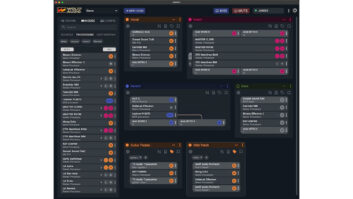Antares introduced the Auto-Tune pitch correcting plug-in for ProTools about two years ago, and the masses went mental. Because it (aswell as the subsequent PC version) corrected the pitch of vocals andsolo instruments without altering the expressiveness of theperformance, Antares was asked to put the same processing in anoutboard unit. Voila!
As the title indicates, the ATR-1 (list price $1,199) is a 1Udigital processor that allows for precise control over the parameterssurrounding pitch correction. It’s quite easy to use and program:Thirteen basic preprogrammed scales (chromatic and A-G major and minorscales) and 37 user-programmable banks make it possible for users tocreate their own scales or songs. What’s more, this unit is extremelyportable and roadworthy, which most engineers and producers willappreciate wholeheartedly.
The ATR-1 detects and measures the time length of the repetitions ofthe input waveform (it works best with periodic sound sources thatinclude vocals and other solo instruments), calculates the frequency ofthat repetition and matches it to a known frequency of preprogrammednotes, ranging from A0 to C6, then shifts the incoming pitch to itsnearest matching frequency, in less than 4 milliseconds.
The ATR-1 is very simple in its layout, offering four balanced andunbalanced inputs as well as MIDI in and a footswitch jack. The frontpanel features an LCD screen, a data entry knob, a few buttons plus avertical LED meter indicating the input signal (input must be highenough for effective pitch correcting, but not so high as to causedistortion), and a horizontal LED meter indicating pitch change incents (10, 30, 50, 70, 90), in both the sharp and flat directions. Onecould even use this unit as a tuner.
The ATR-1 has two modes: Program mode is useful for pieces that useonly one or two scales; Song mode is useful for precise control ofindividual parameters, allowing one to preprogram precisely which notesin a scale will be pitch corrected, how much (if any) vibrato will beadded, how sensitive the unit will be to variances in pitch beforecorrection occurs, and how a series of these settings will be saved forlive or MIDI playback. Song mode is especially helpful in liveperformance situations-each page of a song structure can be programmedand changed with a footswitch.
MIDI-CONTROLLABLE PARAMETERS The Scale parameter allows you tomodify notes in a particular scale (either user-defined or preset) anddefine what the ATR-1 will do with each note: Tune selects which noteswill be pitch corrected; Bypass will skip pitch correction ofparticular notes, allowing the input signal to pass through unchanged;Blank allows you to take a note out of the scale in order to tune it toa specific scale or set of notes. One good example is provided in thewell-written owner’s manual: Say a vocalist likes to drop the pitch ofthe last note of a phrase by three semitones (think Sinatra!). TheATR-1 would normally want to correct the last two notes, but if theunit is programmed to ignore them, everything comes out fine and youdon’t end up in the river.
The ATR-1’s Speed setting is important. When I tested this unit on ajazz swing piece with vocals, the default setting for a chromatic scaleworked pretty well for the lyrics, save a few slides, but bringing thespeed up a few notches allowed those slides to come through unscathed.It would probably be best to leave the ATR-1 off during scat points,but I just had to push those limits, so I left it on. The unit had towork quite hard. If the speed was set slow (15 to 25), vibrato orslides were left intact, yet the main pitch was corrected. If the speedwas set fast (0 to 10), the unit corrected pitch virtuallyinstantaneously. This worked on short pitch durations but couldsometimes remove natural vibrato.
Speaking of which, you can actually create vibrato with the ATR-1!Vibrato settings include Sine for smooth variance of pitch, Square forsharp variances, and Saw for slow incline and sharp decline. You canalso control the depth of pitch variation (0 to 100 cents), rates from0.1 to 9.7 Hz and delay (from 0 to 3,500 milliseconds after the attacknote has sounded).
The ATR-1 is a fine addition to any professional studio-no wonderthe hordes stampeded to buy the original software version. This box isfascinating technology, but I wonder if its use will so distort theaudience’s impression of what music is supposed to sound like that livemusic, with its beautiful flaws and personality intact, will be alet-down. Use with discretion.
Antares Systems, 464 Monterey Ave., 2nd Floor, Los Gatos, CA 95030;888/332-2636, fax 408/399-0036. Website: www.antarestech.com.







